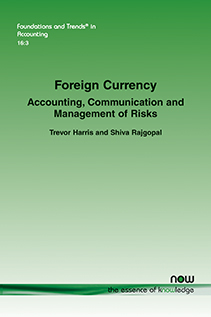Foreign Currency: Accounting, Communication and Management of Risks
By Trevor Harris, Columbia Business School, USA, tsh1@gsb.columbia.edu | Shiva Rajgopal, Columbia Business School, USA, sr3269@gsb.columbia.edu
Abstract
We obtain survey responses from 168 North American CFOs and interview 16 of them to understand (i) how foreign currency exposure is measured and reported inside and outside the firm; (ii) how goal setting, performance evaluation and compensation of managers reflect exchange rate impacts, (iii) what specific currency exposures firms hedge and why? To develop expected answers to these questions, we provide a series of exhibits of hypothetical transactions at, and financial reports for, the foreign subsidiary. We benchmark these theoretical insights against the survey responses and uncover several questionable managerial choices and practices. First, although no performance measure is insulated from a currency impact, a large majority of senior managers and board members only review translated USD data, especially cash flows, that are fraught with significant measurement error. Second, companies are more likely to communicate, both inside and outside, the currency impact on net income and revenue but not on operating costs, operating or (free) cash flows, the balance sheet and all profitability measures. Hence, almost all decision makers, especially investors, will be unable to readily isolate the portion of the firm’s performance attributable to currency changes. Third, many of the current practices used to (i) set budgeted exchange rates for planning; (ii) hold local managers accountable for currency fluctuations; and (iii) manage foreign currency risk are inconsistent both with one another and with theory. We hope our work furthers the understanding of currency exposure among students, academics and practitioners.
Foreign Currency: Accounting, Communication and Management of Risks
Since the fixed exchange rate regime ended, the impact of fluctuating foreign exchange rates has plagued internal and external users of accounting information. Exchange rate volatility impacts real and reported measures of a firm’s business in ways that are complicated and arguably little understood or appreciated by board members, senior executives, analysts, investors and empirical researchers. Foreign Currency: Accounting, Communication and Management of Risks furthers our collective understanding of the measurement and management of foreign currency exposure. To assess how current practice deals with exchange rate volatility, we conducted a detailed field study, consisting of 168 survey responses and 16 interviews with Chief Financial Officers, Treasurers and Controllers (collectively labeled CFOs), to provide systematic answers to four sets of questions related to: (i) reporting; (ii) communication; (iii) budgeting and performance evaluation; and (iv) risk management.
This work is important to academe and practice for several reasons. First, the exhibits created to illustrate the conceptual foundation and the problems associated with foreign currency measurement and management are likely to be useful in learning about these issues both for students and practitioners. Second, the authors show that serious inconsistencies plague the application of foreign currency rates to each line item on financial statements such that most valuations that rely on cash flow data of companies with international operations will contain material measurement error. Third, foreign currency adjustments impact virtually every area of accounting research. Finally, the authors open the black box behind (i) how the translation adjustment number is actually compiled; and (ii) how currency exposure affects capital budgeting, hedging and performance evaluation decisions?
